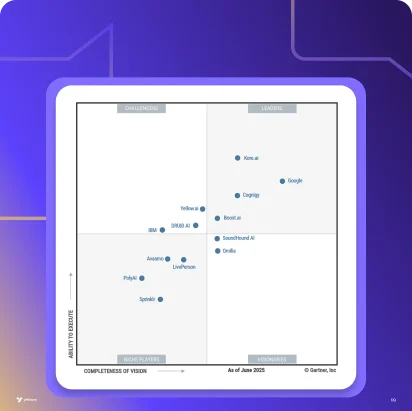Summary
Call centers have long been the cornerstone of customer service, handling everything from routine inquiries to complex issues. However, as customer expectations for speed, accuracy, and availability continue to rise, traditional call center models are pushed to their limits. Enter voice bots for call centers — AI-driven solutions that bring the promise of revolutionizing these customer interaction hubs. By automating responses and providing 24/7 service, voice bots enhance operational efficiency and greatly improve customer satisfaction. This seamless technology integration is essential for businesses aiming to stay competitive in a digitally evolving landscape.
What’s interesting is that voice bots have already demonstrated their effectiveness and high demand in recent years. Experts predict that using voice bots for call center experiences will become commonplace by the end of this decade. The voice bot market is expected to expand at a compound annual growth rate of 18.6% from 2022 to 2027, reaching an estimated size of $98.2 billion by 2027. This indicates that AI bots will gain significant momentum in the coming years. Read on to learn the benefits, essential capabilities, and future trends of voice bots in call centers and understand why they are becoming indispensable tools for modern customer service.
Related must-reads:
- AI Voice Bot – The complete guide to voice chat
- What are voice bots and their use-cases for different industries?
- Voice AI – What is it and benefits of voice AI for business
- How voice bots are transforming customer service in 2024?
- Voice bot in banking: Transforming customer interactions in 2024
Introduction to voice bots for call centers
Definition of voice bots for call centers – Voice bots are AI-powered virtual assistants designed to interact with customers through voice commands. These bots utilize advanced technologies such as automatic speech recognition (ASR), natural language processing (NLP), and machine learning to understand and respond to customer inquiries in real-time. By simulating human conversation, voice bots provide a seamless and efficient communication channel for customers.
The increasing need for automation in call centers – Ever rising call volumes and the heightening customer expectations for round-the-clock service are making it increasingly challenging for businesses to meet the demands with only human agents. Without automation, expected levels of efficiency are extremely hard to meet, and not to mention it leads to colossal operational costs. Voice bots alleviate this pressure by handling routine queries, thus reducing queue times and enhancing customer satisfaction. Additionally, since voice bots can handle multiple calls simultaneously, they enable call centers to scale their operations dynamically during peak periods without the need for proportional increases in staffing. This strategic deployment of voice bots helps maintain a high level of service while managing costs effectively, ensuring that resources are focused on areas where human expertise is most needed.
Key features and capabilities of voice bots for call centers
Voice bots come equipped with various features designed to enhance call center operations and improve customer interactions. Here are some of the key capabilities that make voice bots indispensable tools in modern call centers:
1. Natural Language Processing (NLP)
Natural Language Processing (NLP) is a fundamental feature of voice bots, enabling them to understand and respond to customer queries with high accuracy. NLP allows voice bots to interpret the nuances of human language, including slang, accents, and varied speech patterns. This capability ensures that customers receive relevant and accurate responses to their inquiries, enhancing the overall interaction experience.
For example, when a customer asks a voice bot for account information or needs assistance with troubleshooting, NLP helps the bot understand the context and provide precise answers. This reduces the need for customers to repeat themselves or clarify their questions, leading to more efficient and satisfying interactions.
2. Integration with CRM systems
Seamless integration with Customer Relationship Management (CRM) systems is another crucial feature of voice bots for call centers. This integration allows voice bots to access and update customer information in real-time, providing agents with a unified view of customer data. By connecting with existing call center software, voice bots ensure that all interactions are logged and managed efficiently.
Agents can quickly retrieve customer history, preferences, and previous interactions, enabling them to offer personalized and informed assistance. This improves the customer experience and streamlines workflow, reducing the time spent on data entry and retrieval. Overall, integrating voice bots with CRM systems enhances operational efficiency and ensures a seamless, cohesive customer service experience.
3. Real-time analytics and reporting
Real-time analytics and reporting are essential features of voice bots, providing valuable insights into performance and customer interactions. By monitoring key metrics, such as call duration, resolution rates, and customer satisfaction scores, call centers can gain a comprehensive understanding of their operations.
Using this analytical data for continuous improvement is a significant advantage. Voice bots can identify patterns and trends in customer interactions, highlighting areas for enhancement. For instance, if a specific query frequently leads to long call times, the bot can suggest adjustments to streamline the process. This ongoing analysis helps call centers to optimize strategies, improve service quality, and adapt to changing customer needs.
4. Instant and empathetic handling common inquiries
Voice bots are adept at handling common inquiries, making them invaluable assets for call centers. They can efficiently answer frequently asked questions (FAQs) and provide information on various topics such as account details, service hours, and product information. This capability ensures customers receive immediate and accurate responses to their basic queries. Additionally, voice bots streamline simple transaction processes, such as balance checks, order status updates, and appointment scheduling. By managing these routine tasks, voice bots improve the customer experience and free up human agents to focus on more complex and high-value interactions.
5. Advanced problem resolution
Voice bots are equipped to handle more than just simple queries. For advanced problem resolution, they can seamlessly escalate complex issues to human agents while maintaining context throughout the interaction. When a call is transferred to a human agent, all relevant information gathered by the voice bot is passed along, ensuring a smooth and efficient transition. This capability reduces the need for customers to repeat themselves and helps agents quickly understand and address the issue. By handling initial interactions and accurately escalating when necessary, voice bots enhance the overall efficiency and effectiveness of the call center.
6. Speech synthesis
Voice bots not only understand spoken language but can also reply coherently using speech synthesis. This feature allows voice bots to deliver human-like responses, making interactions more engaging and less robotic.
7. Adaptive learning
Through machine learning algorithms, voice bots can continuously improve their interactions based on past conversations. This adaptive learning capability enables the bots to become more efficient over time, offering responses that are increasingly accurate and contextually appropriate.
8. Multilingual support
Voice bots equipped with multilingual capabilities can serve a diverse customer base, breaking language barriers that might otherwise hinder customer service. They can recognize and respond in multiple languages, which is crucial for global businesses aiming to provide localized support without the need for multilingual staff.
9. Emotion recognition
Advanced voice bots can analyze vocal cues to detect customer emotions and modify their responses accordingly. This emotional intelligence allows bots to handle sensitive interactions more tactfully, enhancing customer relations and potentially de-escalating conflicts before they require human intervention.
10. Self-service capabilities
Voice bots facilitate effective self-service options that allow customers to solve problems or access services without human assistance. This feature is especially beneficial for handling high volumes of simple requests, such as password resets or account status updates, thereby freeing up human agents for more complex issues.
Key benefits of implementing voice bots in call centers
1. Enhanced customer experience
Voice bots significantly enhance the customer experience by providing 24/7 availability and instant responses to inquiries. Unlike human agents who work in shifts, voice bots are always ready to assist, ensuring customers receive support whenever needed. This constant availability leads to higher customer satisfaction as issues are resolved promptly. Additionally, voice bots offer personalized and efficient customer service by leveraging AI to understand customer preferences and past interactions. This allows them to deliver tailored responses and recommendations, making each interaction more relevant and engaging for the customer.
2. Operational efficiency
Implementing voice bots in call centers greatly improves operational efficiency. They reduce call wait times by handling multiple inquiries simultaneously, which is particularly beneficial during peak volumes. This capability ensures that customers spend less time on hold and receive quicker assistance. Voice bots also automate repetitive tasks such as answering common questions, processing simple transactions, and gathering preliminary information. This automation frees up human agents to focus on more complex and value-added tasks, enhancing their productivity and allowing them to provide better support for intricate customer issues.
3. Cost savings
Voice bots help call centers to achieve substantial cost savings by automating routine tasks and reducing the need for a large human workforce. Lower operational costs are achieved through reduced labor expenses and minimized errors associated with the manual handling of repetitive tasks. Also, voice bots are scalable solutions that can easily adapt to increasing call volumes without proportional increases in staffing costs. This scalability improves return on investment (ROI) as call centers can manage more interactions efficiently and effectively. By investing in voice bots, businesses can optimize resources, reduce overhead costs, and maximize profitability.
Yellow.ai’s case study and success story
Sony enables round-the-clock service with voice automation
Sony’s challenge
With a rapidly expanding customer base and a vast network of dealers, Sony India faced challenges managing the influx of customer queries. The limited availability of customer service agents, especially after working hours, resulted in delays in addressing customer needs. To tackle this, Sony sought a solution that could provide 24/7 support for sales and service inquiries, seamlessly integrating with their existing CRM system.
The solution: Voice AI – Isha
To meet these demands, Sony collaborated with yellow.ai to deploy Isha, a voice AI agent designed to offer round-the-clock service in English, Hindi, and Bengali. Isha enables customers and dealers to access essential services anytime, such as device registration, troubleshooting, product inquiries, installation requests, and store locations. It also facilitates smooth transfers to live agents for more complex issues. The AI solution is tightly integrated with Sony’s CRM, ensuring user data is accurately collected, analyzed, and used to deliver personalized, location-specific services.
Benefits of implementing Yellow.ai’s voice AI Solution
- 24/7 service availability: The introduction of Isha allowed Sony to launch a dedicated 24/7 helpline, effectively managing customer inquiries around the clock.
- Improved efficiency: Handling over 46,000 calls per quarter, Isha significantly reduced the burden on human agents, leading to substantial person-hour savings.
- Enhanced self-service: With over 13,000 monthly service requests processed through the voice AI agent, Sony achieved quicker customer fulfillment and higher satisfaction rates.
- Increased lead generation: Isha’s efficient handling of inquiries led to a 5% month-on-month increase in product and demo requests, enhancing lead generation efforts.
Customer feedback and satisfaction“With deep back-end integration with the Sony CRM, the voice AI agent collects, records and analyzes user information to deliver personalized experiences. We are pleased to join hands with Yellow.ai for their support in taking Sony’s exceptional customer service support a notch higher. Within two months of going live, Isha has successfully handled over 21,000 customer and dealer calls with seamless integration.”
— Vishal Mathur, National Head of Customer Service, Sony India
Future trends of voice bots in call centers
The future of voice bots in call centers is set to be shaped by significant advancements in AI and voice technology. Custom neural voice technology will enable bots to imitate human voices, creating more natural and engaging interactions that closely mimic human conversation. This development will significantly enhance the customer experience, making interactions with voice bots more pleasant and efficient.
Voice biometrics will play a crucial role in enhancing security through voice print verification, one of the top methods for two-factor authentication (2FA). This technology will ensure that customer interactions are secure and reliable, reducing the risk of fraud and improving trust in automated systems.
Additionally, neural network technology and deep learning will significantly improve the ability to provide complex responses. These advancements will enable voice bots to understand the customer’s intentions more accurately and offer proactive solutions. Voice bots can handle more complex queries and provide detailed, context-aware responses, making them more effective in resolving customer issues.
These advancements will make voice bots more sophisticated and capable, ensuring exceptional customer service and operational efficiency in modern call centers. As AI continues to evolve, voice bots will become indispensable tools, revolutionizing how call centers operate and deliver customer service.
Conclusion
As we wrap up our deep dive into voice bots in call centers, it’s clear that these aren’t the clunky, frustrating bots of the past. Contrary to the outdated perception of robotic, slow, and ineffective bots, today’s voice bots are powered by sophisticated AI, delivering intuitive, engaging, and highly effective customer interactions. These AI-driven allies are reshaping how call centers operate, making them essential components of modern customer service strategies. With their ability to provide continuous, efficient service and deep integration capabilities, voice bots are transforming both the customer experience and operational productivity while offering the significant advantage of reduced operational costs.
For call centers ready to embrace the future, the choice is clear. Leveraging a powerful voice AI solution like yellow.ai not only meets the high standards of today’s customer service demands but also positions your business at the forefront of innovation, ensuring that your customers keep coming back for more.






















